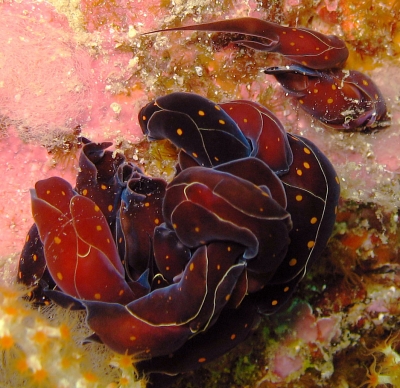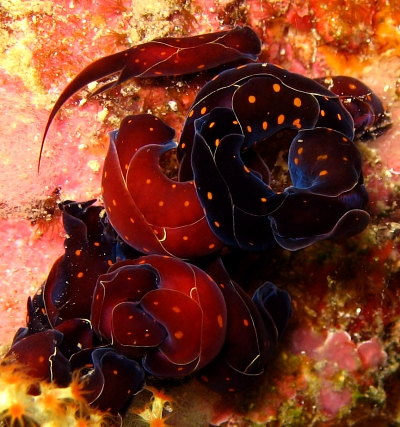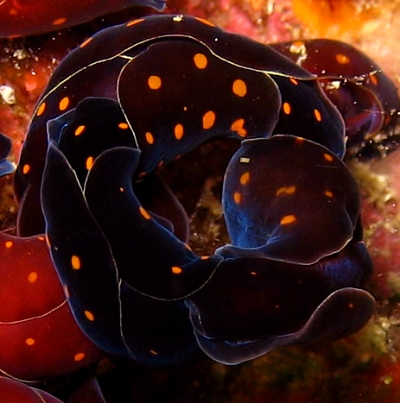Breeding aggregation of Chelidonura punctata
May 2, 2006
From: Wannapa Thammasangwan


Concerning message #16377:
Dear All,
I am fond of nudibranchs and whenever I dive I often look for them. On 12-17 April 2006 I took a trip to the South Andaman Coast starting from Phuket to Li-pe Island. We had a great trip exploring sea creatures and we were amazed with how wonderful they are.
By the way, while the other 5 in my group swam one way, another friend and I went another way. The group of five encountered a whaleshark up close, while my buddy and I found some lovely and tiny creatures.
I am not sure of what I saw. Please kindly see the attached picture and inform if they were mating or what. I saw some singles around the bush which I didn't recognize. At first, I thought the bush was the eggs they laid but when I zoomed my photos, I found that it looked like ten or more of them cuddling together.
Locality: Ha Yai Island, 10-15 M. , Thailand, South Andaman, 15 April 2006, Rock. Length: 3-5 cms. Photographer: Wannapa Thammasangwan.
I think they are the Chelidonura punctata as well?? I will appreciate if I get a reply on this.
Best regards,
Jose
Koihidekun@hotmail.com
Wannapa Thammasangwan, 2006 (May 2) Breeding aggregation of Chelidonura punctata. [Message in] Sea Slug Forum. Australian Museum, Sydney. Available from http://www.seaslugforum.net/find/16512
Dear Jose,
I am sorry you missed the whale shark experience but I am glad you found this interesting cluster of Chelidonura punctata. They are definitely mating. In the close-up of one of your photos alongside you can see three animals forming a mating ring. Species of Chelidonura have their penis on the right side of the head and their female genital opening on the right side, about two-thirds of the way down the body. If you see and animal with its head on the right side just under the parapodial flap then you can be pretty sure it is mating. As they are hermaphrodites they can act as male and female at the same time. In this photo all three animals appear to be mating simultaneously.
There is a photo on the Forum showing three Chelidonura livida mating in a chain [see message #8036]. The Sea Hares are another group which can mate in chains like this [see Mating Chain Fact Sheet].
I am not sure if groups of Chelidonura together like this can be compared with the huge aggregations we sometimes find with Sea Hares [see Mass Mortality Fact Sheet]. I think the ecology of hunting carnivores would be different from that of grazing herbivores like the Sea Hares. Perhaps the Chelidonura were attracted by a population explosion of small flatworms. which they eat. We still have much to learn about these animals. They may be a lot smaller than Whale Sharks but they are just as fascinating.
Best wishes,
Bill Rudman
Related messages
-
Chelidonura punctata from Mayotte
From: Fabrice Schubert, December 23, 2009 -
Chelidonura punctata from Madagascar
From: Eric van Poppel, November 16, 2009 -
Chelidonura punctata from South Africa
From: Valda Fraser, September 7, 2007 -
Chelidonura punctata from Thailand
From: Vie Panyarachun, April 18, 2006 -
Chelidonura punctata from Burma
From: Sergey Parinov, July 16, 2005 -
Chelinodura punctata from Reunion Island?
From: Philibert Bidgrain, July 2, 2005 -
Chelidonura punctata in South Africa
From: Colin Ogden, June 27, 2005 -
Chelidonura punctata from Mauritius
From: Marina Poddubetskaia , November 11, 2002 -
Chelidonura punctata from Thailand
From: Erwin Koehler, January 17, 2001 -
Chelidonura punctata from the Maldives
From: Erwin Koehler, October 10, 2000
